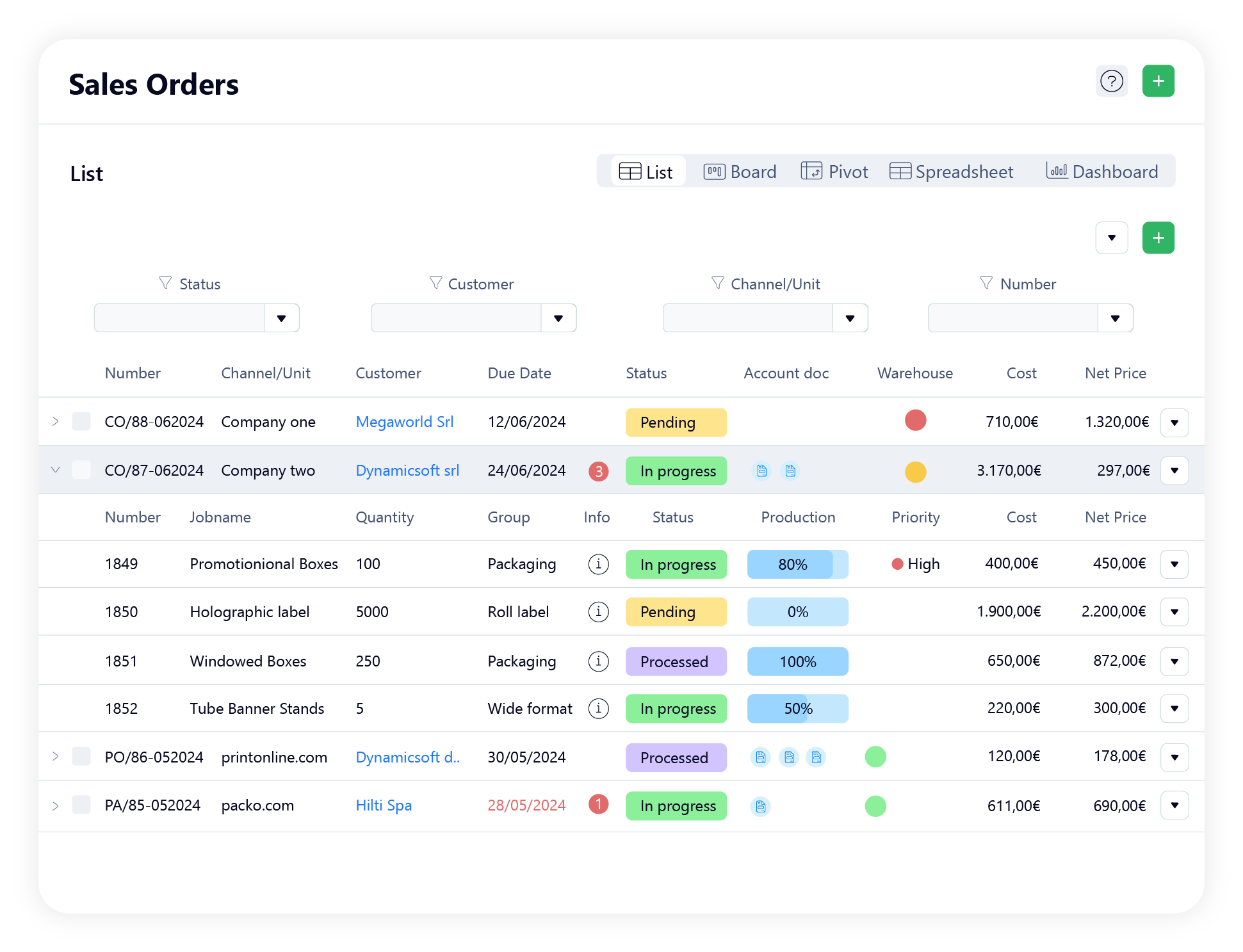How to Manage Sales Orders in Print & Packaging with Maximum Efficiency
Advanced Strategies for Efficient Order Management in the Printing and Packaging Sector
Introduction
Order management in the world of printing and packaging is often a complex process: each customer has different needs, each product can have specific variants (sizes, materials, processes), and the flow from confirmation to production and shipment can become an operational challenge. Wsc Printer simplifies and centralizes all this in a single interface, fully integrated with prepress, production, logistics, and billing departments. Whether it's labels, corrugated cardboard packaging, displays, brochures, or customized boxes, the platform allows you to:
- Quickly manage even complex orders
- Track all phases in real time
- Automate approval and administrative flows
- Integrate external sources for the automatic import of orders
The result? More efficiency, fewer errors, and greater customer satisfaction.

Measurable Data and Impacts
Companies in the printing and packaging sector that have adopted Wsc Printer for order management have seen tangible and measurable improvements within the first few months of use. Here are some key results gathered from real cases:
- The average time to manage a single order has decreased from about 26 minutes to just 8 minutes, thanks to process automation and data centralization.
- Errors in order information collection (such as incorrect customer data, wrong quantities, incomplete formats) have reduced by 88%, from an average incidence of 12% to less than 1.5%.
- The time required to send an order confirmation to the customer has drastically reduced: from a range of 12-24 hours to an average of just 1-3 hours, improving commercial responsiveness and customer satisfaction.
- Sales and customer service operators are able to handle up to 55 orders per day per person, compared to 20 previously, with a productivity increase of over 170%.
- Administrative activities such as generating DDTs, invoices, and confirmations have been streamlined, reducing the time from 5 minutes to less than 30 seconds per order.
- Corporate customer satisfaction (measured through internal surveys and post-sale feedback) has increased from 72% to 94%, especially regarding the traceability of order status and clear communication at every stage.
Main Advantages
- Operational efficiency: By automating each phase - from receipt to billing - you reduce downtime and manual activities.
- Centralized control: All orders are visible, editable, and traceable in real time from an intuitive dashboard.
- Customer customization: Price lists, delivery conditions, approval cycles, and document layouts tailored to each customer.
- Error reduction: Automatic validations prevent the entry of incomplete or inconsistent orders.
- Integration with existing systems: Connection with ERP, CRM, warehouse systems, prepress software, and logistics.
- Scalability: Perfect for managing both a few complex orders and hundreds of multi-product daily orders.
Annual Economic Loss Without This Technology
A medium-sized company in the printing and packaging sector processing 100 orders a day could lose:
- About 400 man-hours a month in non-automated manual activities
- Up to €60,000 per year in errors, rework, lost time, and service disruptions
- 15–20% of potential turnover due to untracked orders, delayed quotes, or dissatisfaction of B2B customers
- Strategic customers who are looking for more digitized and transparent suppliers in the process
FAQ (Frequently Asked Questions)
-
How can Wsc Printer help manage orders with many variants (e.g., sizes, materials, quantities)?
- The system allows you to configure dynamic rules for each product: you can precisely manage different sizes (e.g., A4, 70x100, die-cut), types of materials (coated paper, corrugated cardboard, composite materials), and combinations of quantities for digital or offset runs.
-
Is it possible to create customized price lists for different customers?
- Yes, each customer can have their own customized price list with discounts, price ranges based on quantities, payment conditions, included or excluded processes, and automated surcharges (e.g., emergency management, dedicated transport).
-
How are order confirmations and graphic approvals managed?
- You can set up automated flows for sending order confirmations via email or customer portal, attaching graphic draft and technical PDF. The customer can digitally approve or send modification requests, all tracked with timestamps.
-
Does the system support multichannel requests (email, website, agents, B2B)?
- Yes, you can receive orders from integrated e-commerce, corporate CRM or ERP, agents with limited access, customers via B2B portal, automatic import from CSV, XML, API files. All orders flow into the same operational stream, avoiding duplicates or errors.
-
Does Wsc Printer allow the management of periodic or cyclical orders?
- Of course, you can schedule recurring orders (e.g., monthly, seasonal), very useful for packaging of continuous products, promotional materials, retail displays. It is also possible to manage automatic reordering when reaching a minimum stock threshold.
-
Can I view the status of production and shipment directly from the order?
- Each order is linked to the production and logistical cycle. In one click you can view the status of production phases (prepress, printing, finishing, quality control), estimated delivery date, shipment tracking, and associated documentation (DDT, Invoice, Draft, Certifications).
Conclusion
In the printing and packaging sector, where precision, tight timelines, and customization are the order of the day, relying on advanced digital tools is no longer an option, but a necessity. Wsc Printer positions itself as a strategic ally for companies wanting to transform the management of sales orders into a smooth, traceable, automated, and integrated process. Thanks to its modular structure, flexibility in managing customers and products, and features designed for the real needs of the print & pack world, Wsc Printer allows you to save time, reduce errors, and provide impeccable service to your customers.

Get weekly updates
in your inbox!




